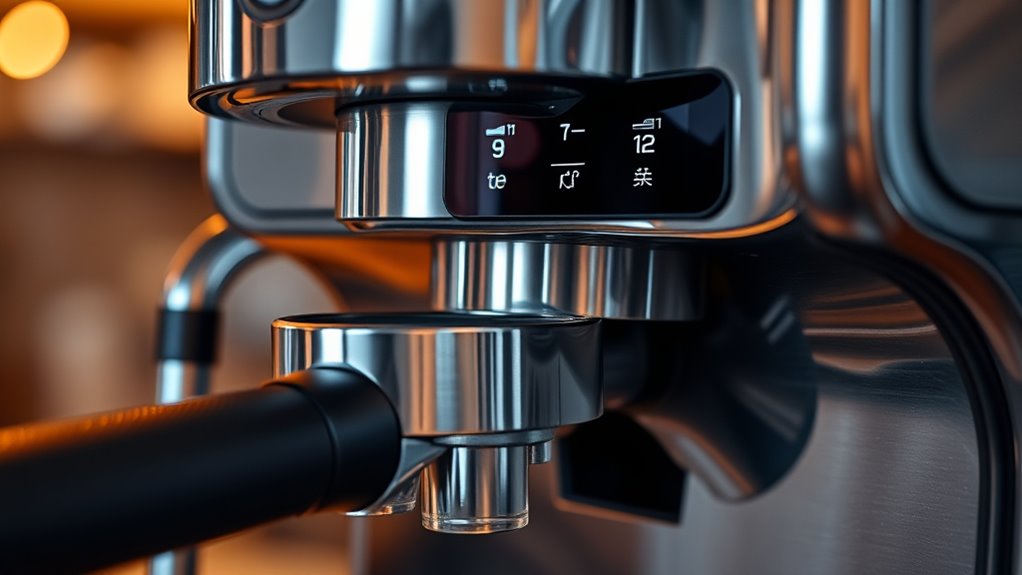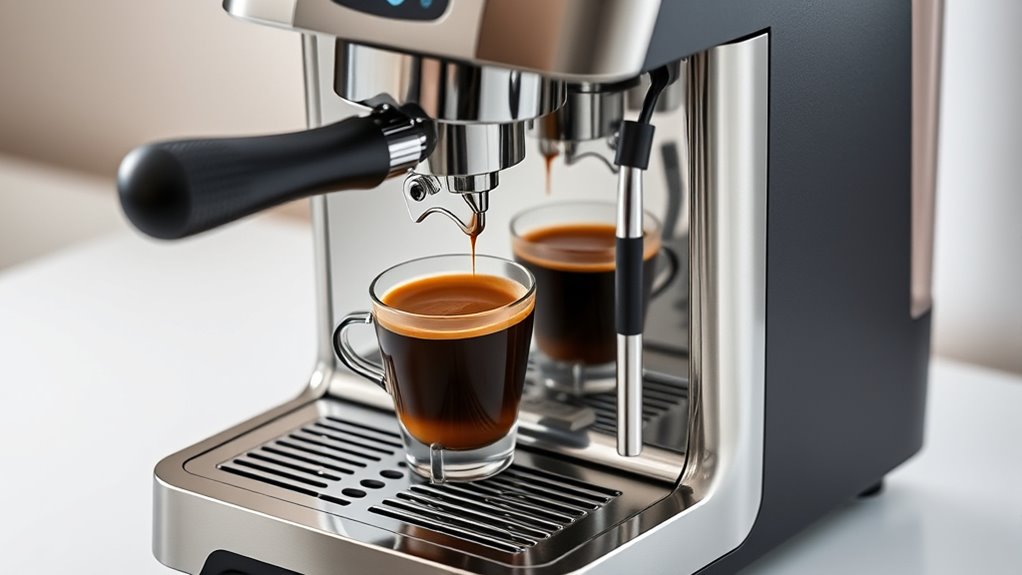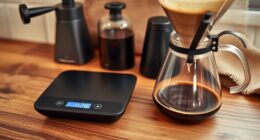When choosing an espresso machine, look for features like a reliable 15-bar pressure system for rich shots, adjustable pressure profiles for customization, and a quality boiler type—single, dual, or heat exchanger—that suits your brewing needs. Consider automation options like programmable shot volumes, built-in grinders, and milk frothing controls for convenience. Additional perks like plumb-in capability, easy maintenance, and compact design can enhance your experience. Keep exploring to find the best fit for your coffee routine.
Key Takeaways
- A reliable 15-bar pressure system with programmable pressure profiles for optimal extraction.
- Suitable boiler configuration (single, dual, or heat exchanger) for brewing and steaming needs.
- User-friendly interface with touchscreens, programmable shot volumes, or automatic functions.
- Effective milk frothing options, including manual wands or automatic frothers, for versatile drinks.
- Easy maintenance features like descaling alerts, removable parts, and self-cleaning systems.

Choosing the right espresso machine depends on understanding its key features, which directly impact your brewing experience. The pressure system is fundamental; a standard 15-bar pressure ensures optimal extraction, giving you rich, well-balanced shots. Some higher-end models allow programmable pressure profiles, letting you customize the extraction process for different beans or preferences.
Choosing an espresso machine with a reliable 15-bar pressure system ensures optimal, flavorful shots every time.
The type of pump—vibration or rotary—also matters. Vibration pumps are quieter and more affordable, while rotary pumps tend to be more durable and produce steadier pressure, leading to more consistent results. Pre-infusion capability is another crucial feature, gently soaking the coffee grounds before full pressure is applied. This reduces channeling and promotes even extraction, resulting in better flavor.
During brewing, pressure stability is vital; a machine that maintains consistent pressure ensures every shot is as good as the last. Additionally, understanding the different boiler configurations can help you choose a machine that best fits your needs, whether for single or multiple functions.
Your choice of boiler configuration will influence how efficiently you can brew and steam simultaneously. Single boilers work well for just brewing, but dual boilers or heat exchanger systems allow you to brew espresso and steam milk at the same time, saving you time. Mid-range models often feature heat exchangers, providing good temperature stability, while thermoblock technology heats water rapidly, ideal for compact machines or quick setups.
If you’re considering a commercial setup, plumb-in capability allows direct water line connection, reducing the need for manual refilling. The boiler material—stainless steel or brass—also impacts heat retention and durability, with stainless steel typically offering better longevity.
Automation levels vary considerably. Manual machines give you complete control over the extraction process, perfect if you enjoy fine-tuning every shot. Semi-automatic models offer programmable shot volumes, balancing control with convenience. Super-automatic machines take automation further, integrating grinders and milk frothers, ideal for quick, consistent drinks at the press of a button.
Touchscreen interfaces on premium models enable easy drink customization, and automatic rinsing cycles simplify maintenance, keeping your machine clean and ready to go.
Milk frothing capabilities are essential if you love milk-based drinks. Steam wands offer manual control over foam density and texture, while automatic frothers provide consistent results with minimal effort. Some machines feature dual-circuit systems, allowing you to brew and froth simultaneously—saving time during busy mornings.
The capacity of the milk container, usually between 8 to 16 ounces, determines how many drinks you can make before refilling. Testing non-dairy milk performance ensures your machine handles alternative milks well, maintaining good texture and flavor.
Built-in grinders, with adjustable coarseness and dose control, ensure fresh beans and precise fills for each shot. Hopper capacity and noise levels are additional considerations—larger hoppers mean fewer refills, and quieter models improve your overall experience.
Maintenance features like descaling alerts, removable brew groups, and self-cleaning milk systems keep your machine running smoothly over time. Size and ergonomic design, including counter footprint, portafilter size, cup clearance, and control layout, influence how comfortably and efficiently you can operate your machine.
Frequently Asked Questions
How Energy-Efficient Are Different Espresso Machines?
You’re wondering about how energy-efficient different espresso machines are. Modern models use insulated boilers and thermoblock heating to cut energy waste.
Single boiler machines consume less power than multi-boiler ones, and features like PID thermostats prevent overheating.
Some have eco-modes and smart scheduling to reduce standby energy use.
Can I Use Pre-Ground Coffee Instead of Beans?
Yes, you can use pre-ground coffee instead of beans in your espresso machine. Just make sure the grind size is fine enough for espresso to avoid under or over-extraction.
Choose blends labeled for espresso, and opt for reputable brands for better flavor.
Keep in mind, pre-ground coffee may lose freshness faster and offers less control over the grind, but it’s a convenient option if you don’t have a grinder or want quick brewing.
Are There Espresso Machines Suitable for Small Kitchens?
Yes, there are espresso machines perfect for small kitchens. You should look for compact, slim designs that save space and are easy to use. Many models, like the Breville Bambino or De’Longhi Stilosa, come with simple controls and fast heating.
They often include milk frothers and can handle pods or ground coffee, making them versatile and convenient for limited counter space. Plus, they’re typically budget-friendly.
How Noisy Are Various Espresso Machine Models?
You wonder how loud your espresso machine might get, don’t you? Some models hum gently around 66-68 dB, barely noticeable, while others can hit up to 80 dB, akin to a noisy conversation.
Brands like KitchenAid keep things quiet, whereas capsule-based machines can be louder during peak use. The noise level depends on the grinder, pump, and design—so choose wisely for a peaceful morning brew.
Do Espresso Machines Require Professional Maintenance?
You might wonder if espresso machines need professional maintenance. While regular cleaning and descaling can often be done by you, some complex issues, like replacing gaskets or valves, require professional help.
Regular professional check-ups ensure your machine runs smoothly and lasts longer. Neglecting maintenance can lead to breakdowns and poor coffee quality, so it’s a good idea to schedule professional service periodically to keep your espresso machine in top shape.
Conclusion
So, after all that, it’s amusing how we chase the perfect espresso, isn’t it? We scrutinize every feature, thinking it’ll transform our mornings. Yet, sometimes, it’s the simple joys—like a good shot and a cozy cup—that truly matter. So go ahead, pick your machine wisely, but don’t forget: no gadget can replace the charm of a well-made brew. After all, perfection is just a brew away—if only we knew where to look.









